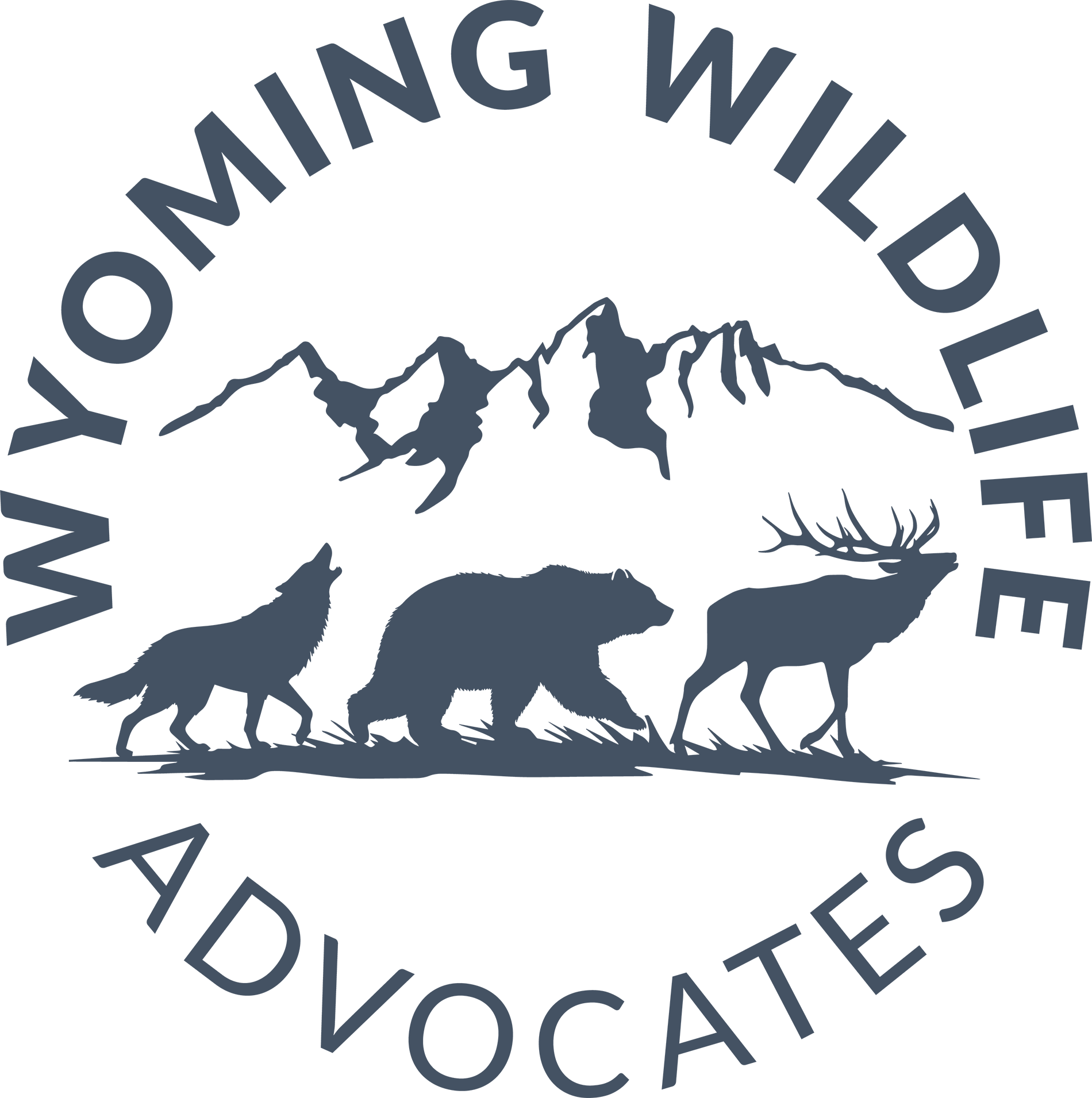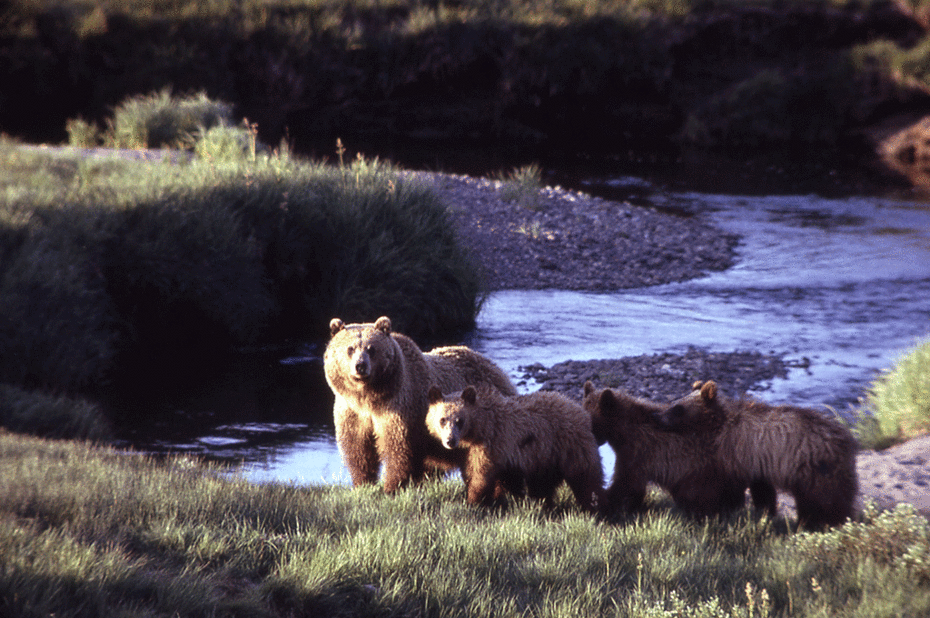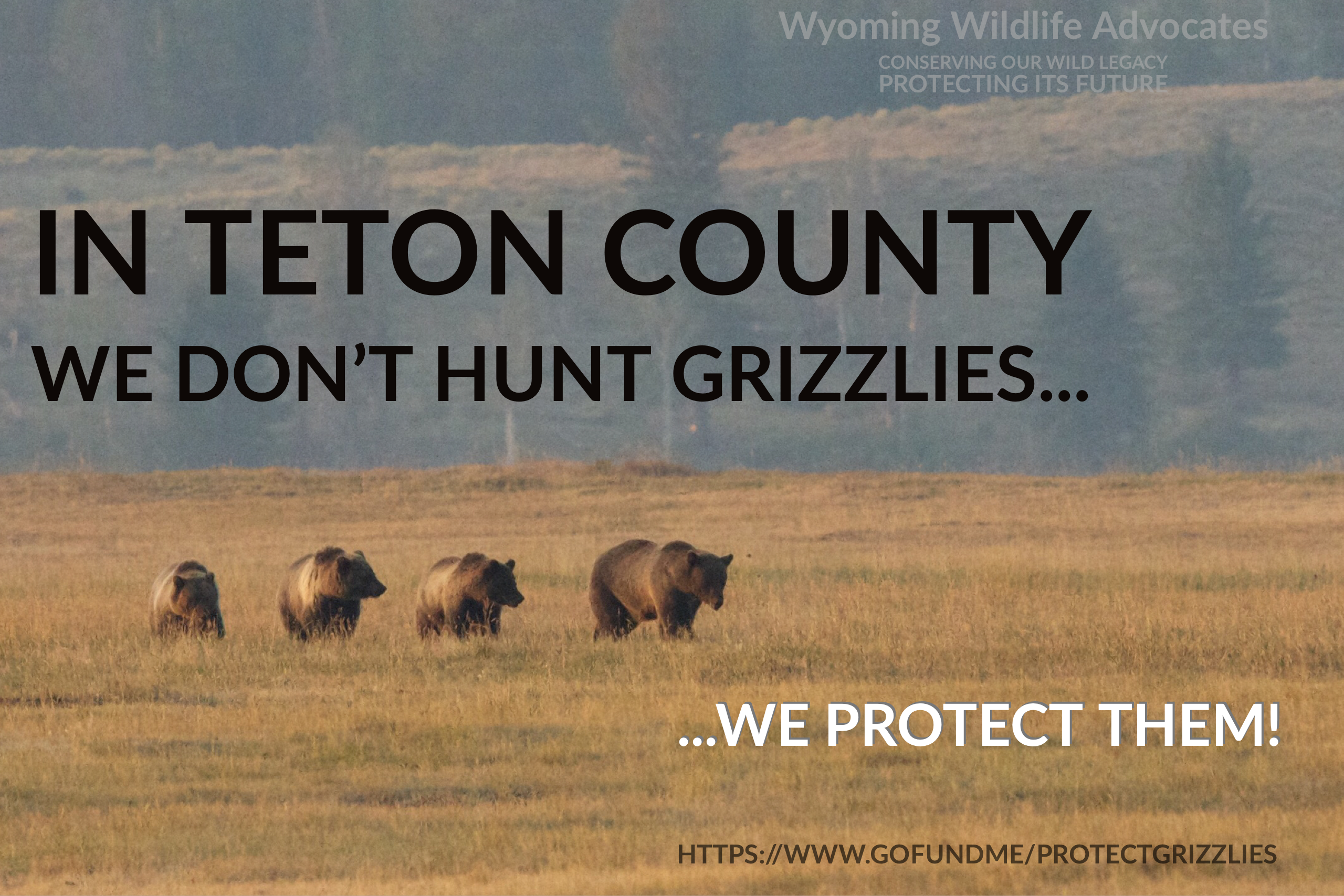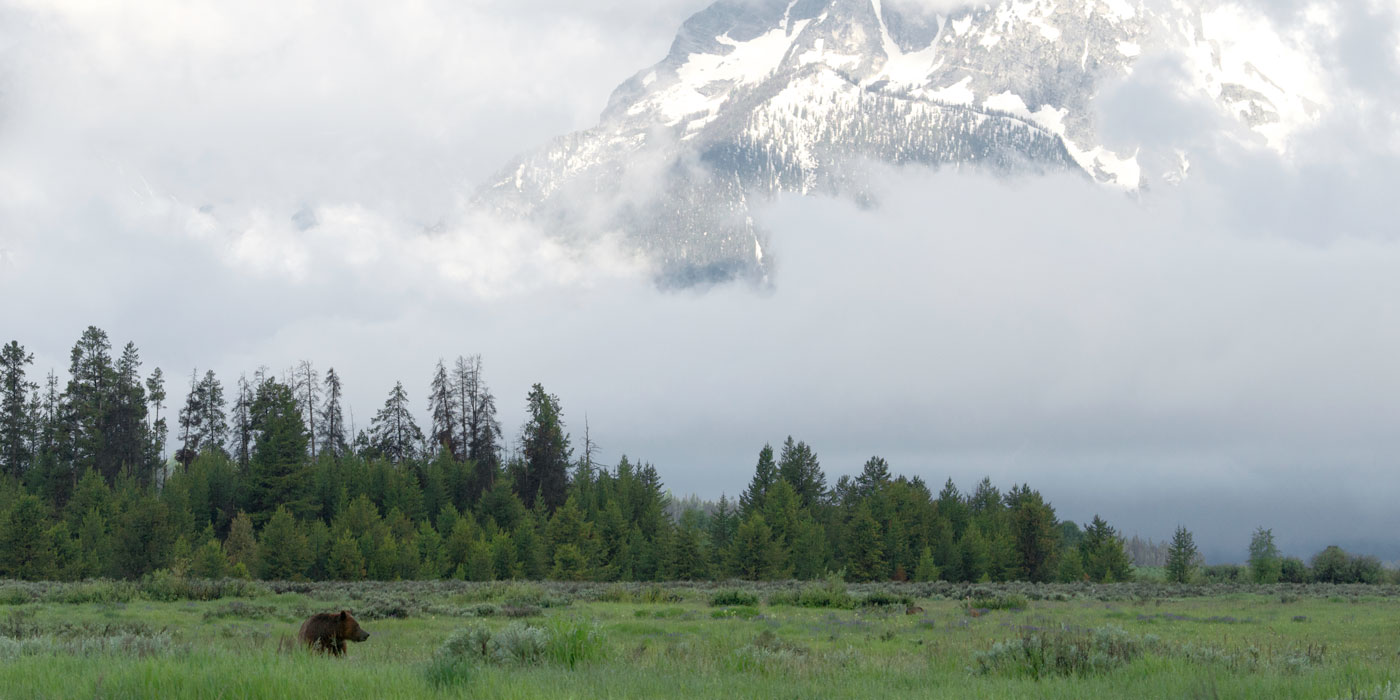by Alexis Sobel Fitts/On Earth | NOVEMBER 19, 2015
Yellowstone’s grizzly bears are spreading out and expanding their range. Is it a sign of good health—or increasing desperation?
Spanning the wall of Chris Servheen’s office at the University of Montana is a weathered map of Yellowstone National Park. In its center, a red ring marks the 9,200 square miles that were set aside by the U.S. Fish and Wildlife Service for Yellowstone’s population of grizzlies in anticipation of the bears’ resurgence—evidence for which has been steadily piling up for years.
Around that red ring, however, is another, much larger circle, this one representing the 19,000 square miles where Yellowstone’s grizzly bears can actually be found. “They’re pushing into those places where we [extirpated] them 100 years ago,” says Servheen, gesturing toward the outer edges of the map. “Now we’re up to our axles in bears. There’s places within this ecosystem where you can’t throw a rock without hitting a grizzly. I like grizzly bears and all, but this is getting pretty crazy.”
A sturdy man with a formidable handlebar mustache, Servheen has worked as Montana’s grizzly bear recovery coordinator for more than three decades. During that time, he has overseen what many consider to be an ursine miracle: Yellowstone’s population of grizzlies, once on the brink of extinction, now appears to be thriving. It’s a shift of fortune that has made a number of people, including Servheen, very happy. But it has also forced him and others to ask a question they never before thought to ask: When it comes to defining recovery, where should we draw the line?
Forty years ago, when the USFWS first listed Yellowstone’s grizzlies as a “threatened” species, estimates indicated there were fewer than 200 of the iconic bears left in and around the park. But under protections afforded to them by the Endangered Species Act—which included the cordoning off of land, a ban on hunting, and the deployment of teams of scientists and wildlife managers to monitor the bears’ progress—the grizzlies began mounting their remarkable comeback. Since joining the list they’ve quadrupled their numbers, and as the map on Servheen’s wall denotes, their current range has expanded well beyond what was allocated for their recovery and into areas bordering the park, including privately owned land.
This has resulted in a heated battle among scientists and other experts over whether Yellowstone’s grizzlies are, in fact, hardy enough to withstand delisting. To hear some people tell it, the bears have recovered completely and no longer merit the “threatened” status bestowed on them by the USFWS more than a generation ago. Others disagree, citing compelling evidence that suggests not only that the bears have not recovered completely, but that they would be placed in harm’s way by any premature decision to remove their federal protections.
At the heart of this counterargument is an inescapable geographical fact. The nearest relatives to Yellowstone’s grizzlies reside in Glacier National Park, 370 miles away, a long and precarious trek for these slow-moving creatures. To put it simply, Yellowstone’s bears aren’t yet populous or wide-ranging enough to be able to connect with their northerly neighbors—a connection many scientists believe is crucial to ensuring the animals’ genetic diversity and their long-term health as a population. These scientists further note that whitebark pine trees, one of the grizzly’s primary food sources, are disappearing from the bears’ Yellowstone habitat due to upticks in wildfires and beetle infestations, both of which can be traced to climate change.
A number of wildlife experts caution that these and other factors, taken together, more than justify keeping Yellowstone’s grizzlies on the threatened-species list. In and of itself, they say, a fourfold expansion of the bears’ overall numbers is a thin measure of recovery. It doesn’t mean grizzlies are no longer vulnerable; it just means we have four times as many vulnerable bears on our hands.
“Are several hundred bears enough in the face of a deteriorating habitat?”
And now the stakes have been raised considerably—by none other than the USFWS itself. In early November, Reuters reported that officials from the agency appeared to be “moving in [the] direction” of recommending the delisting of the park’s grizzlies and have already entered into discussions with the three states in which Yellowstone sits, as well as with tribal leaders, regarding “a plan to manage grizzlies without federal protection.”
The outcome of this battle may well determine the ultimate fate of Yellowstone’s grizzly population. It also has the potential to determine much more. The decision to keep the bears on the list, or to take them off, could set a momentous precedent for what we mean when we declare a species to be “recovered.” Which is why people on both sides of the issue are so desperately concerned with getting it right.
***
In the early 19th century, grizzly bears roamed the central and western United States from Mexico to California. They were so populous that early settlers wrote of them grazing like cattle on clover fields. Lewis and Clark notably encountered a grizzly shortly after they first crossed into the Northern Rockies, having earlier scoffed at descriptions from American Indians of a creature that was bigger and more ferocious than the black bear the explorers already knew well. It took a harrowing 10 shots for the pair to take down the grizzly—which was, as a chastened William Clark later wrote in his journal, “a very large and terrible looking animal, which we found very hard to kill.”
Those who came afterward found a way to kill them all the same. Pioneers either shot the bears or poisoned them with strychnine-laced game. By the mid-1900s, the subspecies known as the California grizzly—the one on the state flag—was extinct, and the total population of grizzlies in the continental United States, once estimated at 50,000 to 100,000, had dropped to just over 1,000. The remaining bears existed in five small clusters on the Great Plains and in western states, on land that represented less than 2 percent of their former range. The southernmost and most isolated cluster of these bears was located in Yellowstone National Park.

From the moment the park opened to the public in 1872, grizzly bears were an attraction that visitors simply couldn’t get enough of. By 1890, the sight of grizzlies feeding at garbage dumps outside hotels in the Mammoth town center had become, for many visitors, an essential part of the Yellowstone experience; park managers even set up bleachers for people to observe the nightly bear shows. But when bear biologists (and twin brothers) Frank and John Craighead arrived in 1959 to begin their famed work with Yellowstone’s bear population, they warned that treating Dumpster-diving as an attraction would lead only to trouble. It was just a matter of time, the Craigheads accurately predicted, before wild bears that had grown comfortable taking handouts from humans began venturing into campsites and becoming aggressive.
In 1967, in Montana’s Glacier National Park, the Craighead brothers’ warning came to pass. A pair of teenage girls, camping 10 miles apart from each other, were killed in two separate grizzly attacks in a single night. Dubbed “The Night of the Grizzlies” by the press, the tragedy forced managers at national parks to begin paying attention to what had quite clearly become a problem. By the following year, Yellowstone had closed off its two main garbage dumps, preventing bears from entering them; the rest were closed off two years later.
It proved to be a disastrous turn for a generation of bears that had been raised on scraps. Unaccustomed to foraging, Yellowstone’s grizzlies began targeting human enclosures, eventually forcing park rangers to put down a great number of animals perceived to be “problem bears.” In the four years that followed the closing of the dumps, 158 grizzly bear deaths were recorded at Yellowstone. By the early 1970s, fewer than 200 of them were believed to inhabit the park. “They have the lowest reproductive rate of any mammal in North America, and you just can’t kill very many of them without having an impact on the fate of the population,” says Louisa Willcox, a former wildlife conservation specialist for the Natural Resources Defense Council who focuses on grizzly bears. (Disclosure.)
Once it became clear that bear numbers were dwindling at a rate that portended the animal’s extinction, USFWS officials put an immediate end to grizzly-hunting season and created a designated recovery area for the bears within the park. They established the Interagency Grizzly Bear Study Team (IGBST), a government-led panel of wildlife experts tasked with exploring strategies for bear recovery, and in 1982 initiated a plan that aimed to increase the grizzly population to a minimum of 500—a number at which, park scientists estimated, the bears could sustain themselves and maintain genetic diversity.

Under these new and far more hospitable conditions, Yellowstone’s grizzly population started to climb again. By the 1990s, it was estimated that the bears’ numbers were increasing, on average, by 7 percent each year, a rate that leveled off to between 1 and 2 percent by the early 2000s. Between 2004 and 2010, bears—apparently feeling the pinch that comes with increased competition for food and other resources—began moving outside the recovery zone, ultimately expanding their range by 98 percent. Today, the diaspora is even more far-flung. “Now bears are well beyond the recovery zone,” says Kerry Gunther, the park’s longtime bear manager. “Every time we draw a line, the bears get out past us.”
Ecologists have taken all of this as an unmistakable sign that Yellowstone’s bears have finally outgrown the space allotted to them. “If you look at any of the classical ecological literature, this is what we interpret as a density-dependent effect,” says Frank van Manen, an ecologist who currently heads the IGBST. David Mattson, a former IGBST member, argues that the bears are facing a perfect storm of existential threats. “You have a very extensive range, incredibly isolated, where the habitat is essentially unraveling,” he says. Given these threats, he explains, any declarations of recovery are highly suspect and shouldn’t be used as a determinative foundation for delisting. All of which leads him to a single question: “Are several hundred bears enough in the face of a deteriorating habitat?”
***
The problem is that—officially, at least—the answer to Mattson’s question is yes. According to the terms set forth in the grizzly bear recovery plan established by the USFWS in 1982, “success” has already been reached: Technically speaking, the park’s grizzlies have met the population goals laid out in the plan. Once that threshold was crossed, officials were quick to publicize what they hoped would be characterized as a conservation triumph. In 2007, the agency announced that Yellowstone’s grizzlies were being removed from the threatened-species list. As then deputy interior secretary Lynn Scarlett wrote at the time, “I believe all Americans should be proud that, as a nation, we had the will and the ability to protect and restore this symbol of the wild.”

But a number of environmental organizations and wildlife conservation groups disagreed with the decision. Thanks in part to an amicus brief filed by the Greater Yellowstone Coalition and the Natural Resources Defense Council that challenged it, the grizzlies were placed back on the list in 2009.
The underlying issues that were raised in 2009 have yet to be resolved. In the ongoing debate, environmental groups have charged that the USFWS has thus far failed to connect the isolated population of Yellowstone grizzlies to nearby populations in Idaho or the Northern Continental Divide, which includes Glacier National Park. Ideas for remedying the situation—such as building a massive “land bridge” that would connect the two bear populations, or flying bears from other parks into Yellowstone—have been floated, but none has reached critical mass.
Nevertheless, some see this kind of intervention as a necessary component to the future of wildlife preservation, as we continue to pack creatures into ever-shrinking parcels of habitat. “It’s a reflection of the landscape that we’ve left for our top predators,” says Stuart Pimm, a conservation biologist at Duke University who has worked extensively on the recovery of the Florida panther. “We’ve fragmented the landscape. Grizzly bears are animals that require large swaths of land, and those areas are not available. So if we’re going to maintain a diverse population, we’re going to have to manage the species.”
In the years since the USFWS’s delisting decision was reversed, the debate over the Yellowstone grizzlies’ recovery has expanded to include disagreement over how many bears there even are in Yellowstone. In early 2013, one study put the number at a relatively hearty 741. But a second study, published that July in the journal Conservation Letters, cast doubt on the survey methodology of the first study and said that its estimates were most likely inflated. In a rebuttal, park officials published an article in the same journal that recalculated the estimated number of grizzlies in the park, using a new formula that they argued was even more accurate than the first. The new estimate placed the population of bears at more than 1,000.

There has also been discord over how to interpret the rapid disappearance of the grizzlies’ favorite food from their Yellowstone habitat. The park’s hilltops used to be abundant with whitebark pine, a tree that produces a seed similar to what we call a pine nut. High in fat and nutritionally dense, these seeds are an excellent source of food for grizzly bears, which typically feed off the trees all summer long. But climate change, sadly if predictably, has interfered. Rising temperatures have led to the proliferation of whitebark pine’s natural predators—pine beetles and white pine blister rust—and the trees’ numbers are in decline. All this comes after another of the bears’ major foods, the Yellowstone cutthroat trout, has been virtually eliminated, thanks to an invasive and highly predatory species of trout that was introduced to the park’s waterways in the 1980s and quickly laid waste to the cutthroat trout’s spawning areas.
The IGBST, meanwhile, has been preparing studies that could be read as underplaying the significance of whitebark pine loss to Yellowstone’s grizzlies. The bears, the group argues, are highly adaptable omnivores; one study supported this assertion by documenting 266 different species that grizzlies have been known to eat. And a 2013 survey of the bear population published in the Journal of Wildlife Management noted that body fat in grizzlies didn’t appear to decrease during years of poor pine seed production. (To make up for the lost fat intake, the report’s authors observed, the bears simply switched to eating meat.) In another study, published in 2014, the authors concluded that the park’s bears did not in fact need to travel longer distances to find food in years when whitebark pines were especially ailing.
But these studies may not take fully into account the ramifications of the bears’ adaptability when it comes to sourcing food. Since it grows at elevations of over 8,000 feet, whitebark pine tends to keep grizzlies high up in the mountains—and away from people. Moreover, studies have documented that Yellowstone’s bears are now eating elk and bison at a greater rate, a shift in behavior that necessarily brings them into closer contact with the ranchers and hunters that ring the park.
Increasingly, keeping bears and people apart from one another is proving to be a Sisyphean task. Thirty years ago, rangers tried to “train” the grizzlies to stay away from the most heavily trafficked paths by shooting them with beanbags or startling them with firecrackers. “We were spanking the bears for behavior we deemed inappropriate,” recalls Gunther. Before long, the animals learned to scatter whenever they saw the rangers’ uniforms or their cars. When rangers out of uniform approached the bears, the creatures backed away—just out of the reach of the rangers’ guns—and simply waited.
These days, Yellowstone has had to hire extra staff in order to effectively patrol what are known as “bear jams,” the clogged roads and pathways that inevitably result when a bear hangs out next to a glut of tourists. With the rise in park visitors and the increase in bear numbers, interactions between grizzlies and people are once again becoming disconcertingly common. Today the park averages about 1,000 bear jams a year; at any given moment during high season, as many as a half dozen of them can be taking place simultaneously throughout Yellowstone.

The fact is that bears still hold sway with tourists. And that fact isn’t about to change. For the millions of people who descend on Yellowstone each year (park attendance has recently skyrocketed, with annual numbers of visitors regularly exceeding three million since 2007), grizzlies still top geysers as the main draw. A 2013 survey found that Yellowstone visitors would be willing to spend an average of $41 extra above the then $25 park entrance fee to somehow increase the likelihood of seeing a grizzly. Moreover, 99 percent of visitors said they expected to see a bear during their visit. About 67 percent actually do.
***
When the Endangered Species Act was ratified in 1975, it promised “a program for the conservation of such endangered species,” along with an assurance that the “ecosystems upon which endangered species and threatened species depend may be conserved.” Once an individual species has been listed, the law prevents it from being hunted, protects its habitat, and mandates the creation of a recovery plan designed to restore a healthy population.
And by nearly every conceivable measure, the ESA has proved tremendously successful at bringing creatures back from the brink of disappearance. Since the act was passed, only 10 of its charges have gone extinct, whereas more than 1,300 species of plants, aquatic animals, and land-based wildlife have been saved. During a time when scientists believe we are on the verge of a sixth mass extinction—in the U.S. alone, some 500 species have disappeared over the past 200 years—impressive recoveries have been tallied in every state in the union, thanks largely to protections afforded by the ESA.
But one thing that’s conspicuously missing from the list is a roster of well-off graduates. As the University of Montana’s Chris Servheen puts it, “The Endangered Species Act needs success stories.” Numerous studies show that most species on the list are on track to meet the qualifications of recovery, but few of them have made that last, great leap off the list. As naysayers are fond of pointing out, only 20 species listed under the ESA have been officially deemed “recovered”—about 1 percent. Moreover, saving animals from extinction is expensive: In 2013, federal and state governments spent $1.7 billion to protect endangered species. This has caused some lawmakers to wonder publicly whether we’re getting enough bang for our species-protecting buck. In one 2011 oversight hearing, then U.S. representative Richard N. “Doc” Hastings, serving as chairman of the House Committee on Natural Resources, ominously charged that the act wasn’t living up to expectations. “The purpose of the ESA is to recover endangered species,” he said, “yet this is where the current law is failing—and failing badly.”
“The Endangered Species Act needs success stories.”
All of this only serves to increase the already enormous pressure on the grizzly bear, one of the most prominent and charismatic creatures ever to be added to the endangered species list, and one that has already met most of the stated goals that would constitute a comeback. Many within the conservation community believe, however, that the grizzly’s current situation, more than anything, reflects the underlying problem with setting such goals in stone. Population numbers and mortality rates by themselves, they say, cannot capture the full story of where a particular animal is on the road to recovery.
Others, like Servheen, worry that by delaying indefinitely any declarations of victory, the more cautious conservationists give critics of the ESA more ammunition for wiping it out entirely. He channels the voice of a critic: “You guys can’t even get it done in Yellowstone, where you’ve got huge amounts of wilderness, and where you’ve done all these things for bears! You’ve got all this science! And you still can’t get across the finish line?”
In 2005, rangers found a grizzly on the Mount Haggin game range, a grassy preserve just southwest of Anaconda, Montana. The spot was 171 miles from Yellowstone National Park and more than 200 miles from Glacier National Park: a midway point that might as well have been deemed a no-bear’s-land. No grizzly had ever been known to make such a trek.
Yet, astoundingly, there he was, a young male, found dead—felled by a hunter. He had been shot by an arrow, which had punctured both of his lungs and clipped his aorta before passing fully through his body. DNA tests revealed he was part of the Glacier tribe. Having ventured more than 200 miles from his pack, he had been heading toward Yellowstone.
Those who argue for keeping grizzlies under the protection of the ESA point to this bear as a sign that grizzlies instinctively want to connect—and that they’re trying against incredible odds to do so, even while humans argue over the best ways to protect and care for them. Ten years after the fact, rangers and wildlife managers have yet to discover another bear that has made it that far on a journey between the two parks. But that doesn’t mean there isn’t a grizzly bear out there right now, desperately trying to find that finish line.







